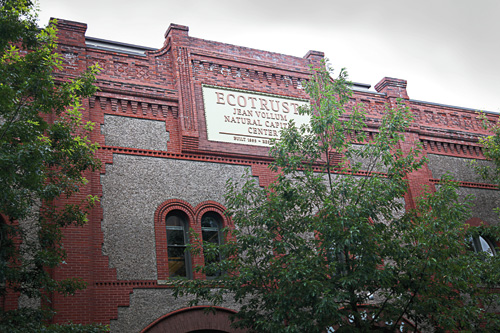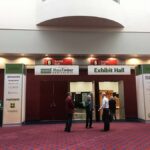 A couple of years after the Natural Capital Center, a pioneering green office building in the Pearl District, was completed in 2001, the LEED gold-rated structure underwent a “post-occupancy evaluation” to see if it really consumed less energy than a conventional office building. The audit showed the structure did meet pre-construction expectations, says Sidney Mead, director of events for Ecotrust, the nonprofit that owns the Natural Capital Center. But several years later, Mead adds, Ecotrust added three new “kitchen-ish spaces,” including a coffee kiosk and walk-in freezer, both of which “used quite a bit of energy.” It was only because the nonprofit also happened to install solar panels that “total energy use came out kind of a wash,” she says.
A couple of years after the Natural Capital Center, a pioneering green office building in the Pearl District, was completed in 2001, the LEED gold-rated structure underwent a “post-occupancy evaluation” to see if it really consumed less energy than a conventional office building. The audit showed the structure did meet pre-construction expectations, says Sidney Mead, director of events for Ecotrust, the nonprofit that owns the Natural Capital Center. But several years later, Mead adds, Ecotrust added three new “kitchen-ish spaces,” including a coffee kiosk and walk-in freezer, both of which “used quite a bit of energy.” It was only because the nonprofit also happened to install solar panels that “total energy use came out kind of a wash,” she says.
 |
The Natural Capital Center in Portland where total energy use “is kind of a wash.”Photo by Alexandra Shyshkina |
A couple of years after the Natural Capital Center, a pioneering green office building in the Pearl District, was completed in 2001, the LEED gold-rated structure underwent a “post-occupancy evaluation” to see if it really consumed less energy than a conventional office building. The audit showed the structure did meet pre-construction expectations, says Sidney Mead, director of events for Ecotrust, the nonprofit that owns the Natural Capital Center. But several years later, Mead adds, Ecotrust added three new “kitchen-ish spaces,” including a coffee kiosk and walk-in freezer, both of which “used quite a bit of energy.” It was only because the nonprofit also happened to install solar panels that “total energy use came out kind of a wash,” she says.
A leader in the nationwide green building movement, Portland is pushing the envelope when it comes to the use of cutting-edge sustainable building materials and technologies. Now the city and state are exploring what energy experts describe as the next big thing in green building: ensuring that new energy-efficient buildings actually meet expectations once they are occupied.
“The real frontier for driving energy use down is in operations and behavior of occupants,” says Tom White, technical director for Green Building Services, a Portland consulting firm. About 20% to 25% of energy use in buildings “is influenced directly” by those factors, he says.
Energy codes for buildings have become more stringent over the past 15 years, says Alisa Kane, Portland’s green building manager. Nevertheless, she says, “actual energy use has not gone down.” Why? Blame the increase in cell phones, computers, space heaters and other “plug loads” that increase energy use beyond the building’s design expectation. For that reason, says Kane, “Behavior change is the most compelling iteration of work that is going to happen in green building.”
Just how that work will unfold in Oregon is unclear. Over the past few years, Seattle, San Francisco, Austin and Washington, D.C., have passed laws requiring property owners to measure and disclose their energy use, which would help place a market value on a building’s efficiency and provide a benchmark for improvements. During the past two sessions, the Oregon Legislature has considered similar legislation. But those bills failed, in part because of opposition from the Building Owners and Managers Association, (BOMA), which expressed concerns with challenges accounting for tenant behavior, especially in multi-tenant buildings.
“The making public of energy use concerns us because it is not always an accurate picture of a building’s energy performance,” said Wade Lange, vice president of property management for Ashforth Pacific’s Portland office.
So far, Portland is in “the consideration phase,” regarding regulation of energy performance, says Kane. “We’ve been wanting to explore all the different options of how we can work with building owners.”
Until then, the nonprofit Energy Trust already works with property owners to help them measure energy performance. And there are voluntary measures property owners can implement on their own. Ecotrust sets the thermostat at 68 degrees in the winter and between 72-74 degrees in the summer. It’s “quite a bit warmer than most office or retail buildings,” says Mead, adding that one tenant, Portfolio 21, “actually had to change dress code to allow staff to wear shorts.” And according to White, each employee and employer in the building should be of one mind when it comes to managing energy use. As he puts it: “There has to be a synergy between the boiler room, board room and break room.”
Linda Baker




